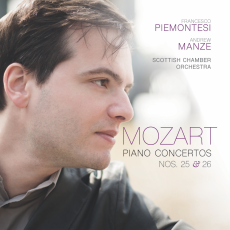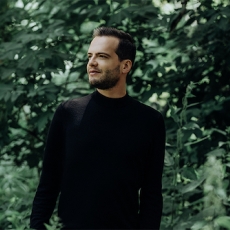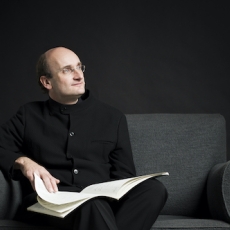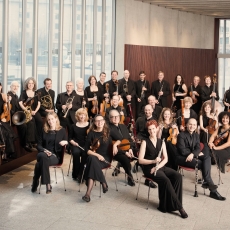Francesco Piemontesi, SCO & Andrew Manze - Mozart: Piano Concertos 25 & 26 - MusicWeb International
Andrew Manze begins Mozart’s Piano Concerto 25 with a grand C major splash but soon reveals a shadowy vein of C minor melancholy as the second violins echo the firsts an octave lower in a 3-quaver-plus-2-crotchet motif. This is soon brushed aside and the motif is tweaked to expand the final note into a song of triumph. Yet the second theme (tr. 4, 1:28) is back in the same rhythmic pattern and C minor, immediately repeated by the oboes in the major with flute garnishing and trumpets and drums chivvying after which - and this is the real magic - the orchestral mood becomes casual, with the suave line of the first violins carefree yet refined. That is the mood of the piano’s entry, glitteringly so in Francesco Piemontesi’s semiquaver runs, as if stating he’s the first to dance. He does so with more wilfulness when the orchestral melancholy returns, provoking him to supply a third theme (4:26), which becomes a variation on the 3-quaver-plus-2-crotchet pattern subjected to a charm offensive. The piano then introduces a dainty fourth theme (5:09). In the development, the piano states the second theme and gradually makes it more civilized and resolute. In the recapitulation the piano meditates upon the third theme, almost cadenza style, Piemontesi giving it a vein of pathos which in turn colours the return of the fourth theme, rendering that more graceful. Mozart left no cadenza; Piemontesi plays one by the pianist Friedrich Gulda. This begins by putting a tranquil cast on the glittering style and is otherwise notable for its charmingly domesticated version of the fourth theme before that is given a rhetorical spine. For me Piemontesi and Manze judge the movement’s style nicely: more galante than bombast; for all the force there is still elegance.
I compared this with a 2001 recording also featuring the Scottish Chamber Orchestra, conducted by Sir Charles Mackerras with pianist Alfred Brendel (Decca 4702872). Mackerras’ opening is more formal, yet he brings more telling colour to the violins’ minor mode material and more swagger to their following ascents. Brendel’s playing is less sparkling than Piemontesi’s, yet has more colour and density in the more reflective passages. His third theme has more shine and sweetness but is also more deliberate in articulation. His fourth theme has more charm. In the development the orchestra seems more involved in the dialogue with the piano; Brendel is more studied at the return of the third theme but without Piemontesi’s pathos, which is partly the result of his allowing it more breathing space. Brendel plays his own cadenza which sports a high-register, triumphant version of the second theme, then becomes in turn more sober, stylish and carefree before displaying a smooth version of the fourth theme, quite flowing but somewhat prolix, the cadenza taking 2:04 in comparison with Piemontesi’s 1:25.
The Andante (tr. 5) is at heart a serenade, tranquil and sunny yet also insistent on its tranquillity and the enjoyment of its own space. Tension is generated by a move from the end of the second phrase to become more florid in expression, a contest between the generally expansive line and demisemiquaver flourishes. The question for the soloist is should the floridity be elaborated and, if so, how far? Piemontesi thinks it should and for me he takes it too far. He starts trimly enough but begins to embellish his line from 2:17 in the second phase of his opening solo, albeit daintily done. However, the rare forays into the low bass register seem to me unduly ugly in tone. When a solo for him alone incorporates three leaps of two octaves, after the first he adds notes between the leaps (from 3:45) and crowns this with a somewhat grotesque rising glissando. Relief comes in a limpid reverie of rising and falling sequences of semiquavers, but at the return of the opening the long note at the end of the first phrase is transformed into nine notes to greet the second. I find that these additions work against what should be the fundamental calm. Mackerras’ and Brendel’s approach to the movement is more expansive, timing at 8:08 to Manze’s and Piemontesi’s 7:22, arguably more Adagietto than Andante. This makes it less sunny but more tranquil, smoother, more delicate and graceful. Brendel adds notes to his line from his very opening entry but less obtrusively than Piemontesi, more in keeping with the calmer overall pulse. His approach to the low bass passages is more discreet and his line generally glides more, though I also find his additions to the passage including three leaps of two octaves over-generous.
The finale (tr. 6) adapts a gavotte from Idomeneo as a rondo theme. It is light and sweet but, as in the first movement, veers into C minor for a spell before rejuvenating in a tutti. The piano solo starts the episode with perhaps a distant variation of the rondo theme, but not enough to be called a theme, rather a combination of quicksilver stuff and glistening musing. Piemontesi’s playing is satisfyingly mercurial. Then a distinct second theme of more substantially joyous mood arrives (1:40) followed by a third of a more striving nature (3:14), arrestingly presented by Piemontesi though it mellows as it progresses. The gem of the movement, however, is a warm and beguiling fourth theme (3:40) in which oboe, flute and cello become involved in turn, a theme which grows in yearning and attractiveness but then just vanishes. We are left with a tinselly but happy enough return of the second theme and Piemontesi’s fingerwork to enjoy, plus a vivacious close. Piemontesi provides some extra embellishments in this movement which here blend successfully with its delightful flow. Mackerras and Brendel, timing at 9:18 to Manze’s and Piemontesi’s 8:49, take a firmer view of this Allegretto. This results in a solidity which turns out to be beneficial, bringing more gusto and bite to the movement, if you fancy more than the lighter hue. Brendel’s episode has more swagger, his second theme starts more charmingly but soon acquires more resilience. A sparkling personality is evident in his third theme while his fourth is conveyed with more longing.
Piano Concerto 26 suffers from Mozart never having fully written it out; the left-hand material is very much a reconstruction, yet that of the Neuen Mozart-Ausgabe as heard here is convincing. All the same, the piece is quite sparse in texture: more piano solo than usual and not that much woodwind involvement. This challenge is also an opportunity for a very clear presentation of the musical argument, and Manze and Piemontesi are so compelling in this that I found myself appreciating the work more. The first movement introduction showcases expectant strings before a jubilant, supremely confident tutti replete with trumpets and drums from which the first violins escape with sinuous grace like a stylish ballerina, leading into a second theme (tr. 1, 1:11) which skips simply and then muses luxuriantly. Presently the violins give us an equally simple yet more dreamily reflective third theme (1:50). Mozart’s interest in contrasts of perspective is apparent and fascinating. The piano enters with its own theme, the fourth in the movement, a cousin of the opening one yet more pointedly decorative, thus bridging the two worlds of the public and individual themes heard hitherto. Piemontesi glides gracefully over all this before becoming more individual in a more thoughtful, leaping fifth theme (3:55) before jauntily launching into the second theme and boldly decorating it alongside the strings’ repeat, rendering it more bullish and complex. In turn this provokes the orchestra to respond with a more heroic statement of the opening theme. The development (7:13) begins with the piano examining in more austere fashion the emphatic closing cadence of the exposition. Piemontesi is clinical, intellectual, playful and arch by turns, while Manze and the SCO try to be an equal partner, though you feel they’re challenged to keep up with the chameleon Piemontesi and relieved at being able to sneak in the recapitulation. Piemontesi reinforces his distinctiveness with a cogent restatement of the fifth theme and furthers his advantage with a more gauche version of the second theme. The orchestra counters with a more elegant restatement of the third theme which Piemontesi decorates with fellow feeling before demolishing it in a stormy outburst. Piemontesi plays Paul Badura Skoda’s cadenza. It begins with inward brooding and convulsive turbulence but then recalls a mood more elegant and beauteous which leads to a chaste, almost saintly, version of the second theme, then visits the more arch and stressed elements of the movement via an indirect recollection of the fifth theme.
I compared the 1993 recording by András Schiff with the Camerata Academica des Mozarteums Salzburg/Sándor Végh (Presto CD reissue of Decca 4438772). Végh’s orchestral introduction is more refined, his tutti has a hearty jubilation, less purposive and forced than Manze’s. Végh’s second theme is more self-consciously coy but his third has exquisite yearning. Schiff’s opening fourth theme is more benign than Piemontesi’s with more of an inward joy and less emphasis on display. Schiff brings a more aching, yearning quality to the fifth theme, a more reflective expressiveness where Piemontesi is more declamatory and in keeping with this Schiff then articulates the second theme more lightly, albeit with a touch of impishness. In the development the characteristics he expresses are resilience, visionary gazing, a poised, rippling beauty then more dazzling aerial manoeuvres as of a gymnast. In sum there is an inner fire here rather than Piemontesi’s more cultivated approach. Schiff’s restatement of the fifth theme has more density, while that of the second theme is quietly dainty, delightful then a playfully probing exploration of its potential. He uses Mozart’s bravura in harmonic twists to emphasise transformation of mood rather than, as with Piemontesi, the piquancy of musical shocks. Végh’s restatement of the third theme is sunnier than Manze’s. Schiff is equally serene in accompaniment yet his vigorous outburst, while adding spice, doesn’t efface the earlier mood. Schiff supplies his own cadenza which concentrates first on the second theme, gently furthering its recent exploration but with a happy continuation before bringing things full circle by articulating the opening of the introduction which Mozart never allows the piano, and then adds a cheeky quotation from the Figaro overture.
The slow movement has only one main theme and that has the same first four notes and largely first two phrases. As it constantly reappears, the challenge is to the pianist’s skill in improvisation. Piemontesi starts with a spruce, dapper presentation; Manze responds cheerily. The second half of the theme has a rising scale of sheer exuberance and in its repeated phrase Piemontesi adds extra notes, relishing the lift-off. Then he can’t resist doing the same with the return of the first part of the theme. At this point I feel less is more, particularly given the repeated listening to a recording. The embellishment of the repeats in the central section is fine, as the theme here is itself a kind of relaxed variation of the main theme while Piemontesi’s own Eingang; the mini cadenza, signalled at 3:15, is a model of taste and I’m by now won over by his delightfully flowing, florid treatment of the further piano solo wanderings around the theme. Come the final return of the original in the orchestra, Piemontesi trills above it and then offers a vivacious contrapuntal accompaniment rather than the marked doubling, to exultant effect. Schiff is gentler, more reflective throughout this movement with an innocent, contented inwardness, whereas Piemontesi looks outward. Schiff’s ornamentation is gentler and not introduced until the repeats in the central section. When the theme finally returns in the orchestra instead of the marked doubling he offers scales in accompaniment but only on its repeat.
As in Concerto 25 the finale is an Allegretto rondo with the main theme a gavotte. Piemontesi showcases it first with an attractive spring to the first beats in the bar and inbuilt excitement as the rhythm of the first half of the phrase is doubled in speed for the second half. Manze’s orchestra responds crisply and gets first crack at the second part of the theme, beginning joyously savouring, then lightly tripping. Piemontesi’s repeat exults in displaying nimble fingerwork, again the speed doubled. The orchestra now indulges in a sequence of swooning descents contrasted with lively syncopation. By now you will have realized this movement is all showmanship but good fun. Piemontesi niftily begins the episode (tr. 3, 1:12) with a second theme which is a distant cousin to the first one and is soon highly varied in development. Then the first violins and bassoon introduce a third theme (2:16) whose initial sobriety quickly gives way to dancing abandon, the latter element again capped by the piano at double speed. Piemontesi’s brief yet ostentatious Eingang at 3:53 is in keeping with the movement’s overall dedication to pyrotechnics. After the return of the rondo theme the third theme is repeated, the piano now developing its lugubrious potential. In his longer Eingang from 7:58 Piemontesi slips in a solemn, then growingly skipping, treatment of it. In a convivial farewell to the rondo theme, the orchestra proposes the start of its opening phrase which the piano triumphantly rounds off. You reflect that it has all been that sort of unequal contest. Schiff’s approach to the rondo is simpler, more innocent. He celebrates the melody’s curvaceous qualities while still attending neatly and clearly to its rhythms. Végh’s orchestra manages to be more jovial than Manze’s within its equally alert response. Both Végh and Schiff treat the second part of the rondo theme more lightly and glidingly. Schiff’s second theme is a purposeful progress. The serious opening of the third theme is given more attention by Végh and Schiff, yet its tripping continuation is more lightly articulated, bringing an engaging deftness to its dancing which is lighter footed than Piemontesi and Manze’s. Schiff’s first Eingang is ripplingly florid, his return to the rondo theme friskier than Piemontesi’s. Schiff’s second Eingang is, like Piemontesi’s, affectionate but through a briefer, very distanced allusion to the rondo theme alone. The Schiff/Végh movement is less bracing than Piemontesi/Manze but calmer and easier on the ear. Curiously it also seems a touch more substantial. Végh’s final proposition of the opening of the rondo theme is demure, Schiff’s response a natural smoothing out.
To sum up, Piemontesi and Manze bring to these two concertos a breath of fresh air, which nicely complements but doesn’t displace their distinguished predecessors.



